Meet the Blood Moon: Explanation, Facts, Myths, When And How to Observe
28th Mar 2024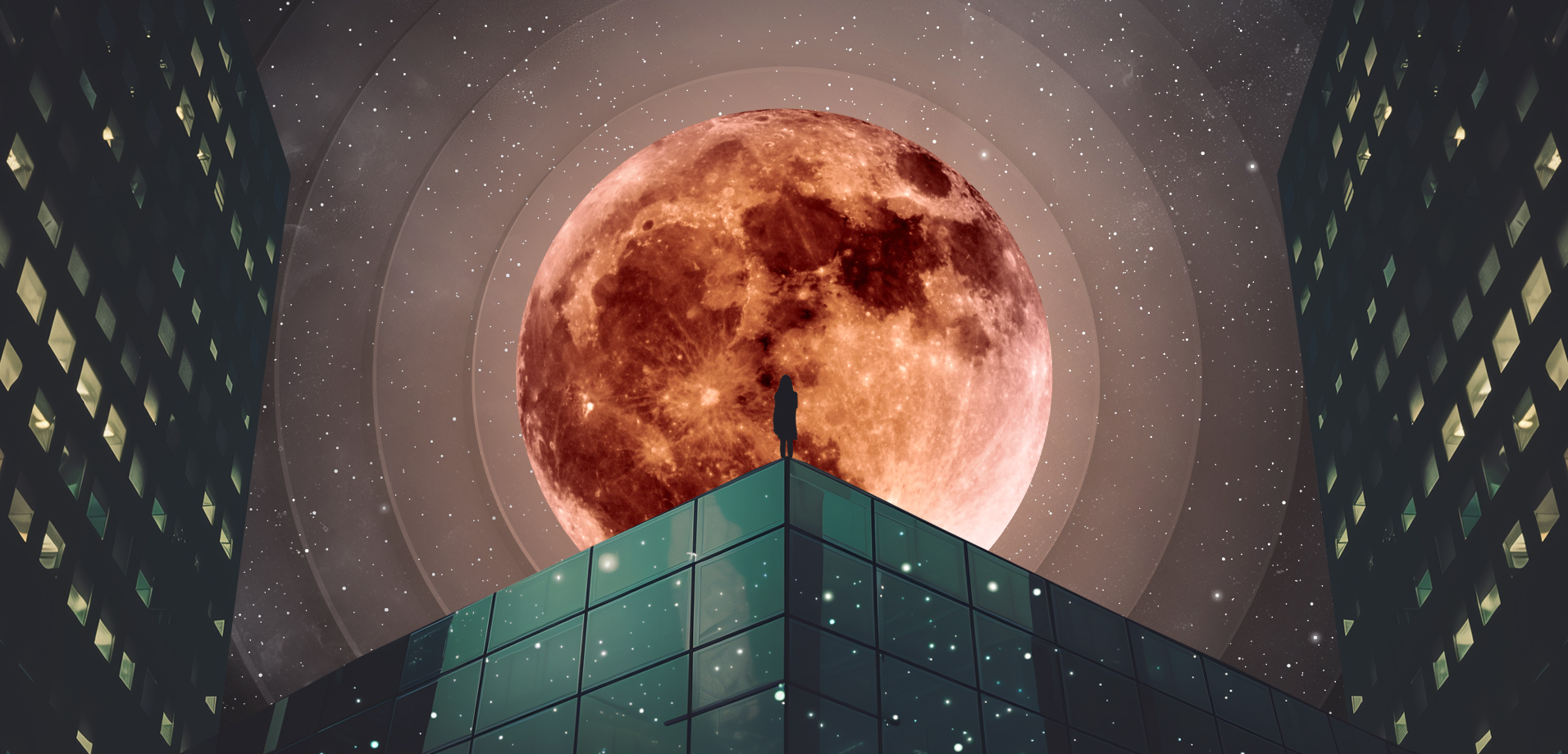
A Blood Moon is an informal name for a total lunar eclipse when the Earth is aligned between the Sun and the Moon, and our satellite completely enters the cone of the Earth’s shadow (called the umbra). Under this condition, the Moon acquires a red tint, which is why it is popularly nicknamed Blood or Red Moon.
What makes a Blood Moon red?
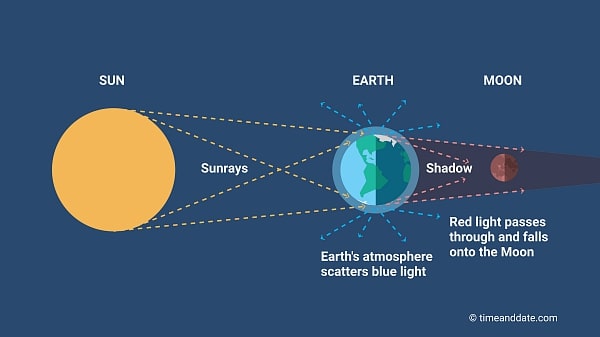
As we recall, our natural satellite does not emit light but reflects the light of the Sun. When the Earth completely hides the Sun from the Moon, sunlight is refracted and scattered, passing through the Earth’s atmosphere, but mainly in the blue and green spectrum, so during a total eclipse only the rays of the red spectrum reach our satellite. That is what causes a Blood Moon.
In 1912, French astronomer André-Louis Danjon proposed a scale for measuring lunar eclipses.

The colour range and brightness during an eclipse are measured using the Danjon Scale. It consists of five points: from 0 (the Moon is almost invisible) to 4 (a very bright red or orange eclipse). If there is a lot of dust, smoke or clouds in the atmosphere, the red colour may be darker and have a brown tint. If the atmosphere is clean, then the shade will be bright and rich.
Why Can We See a Blood Moon Only During a Total Eclipse?
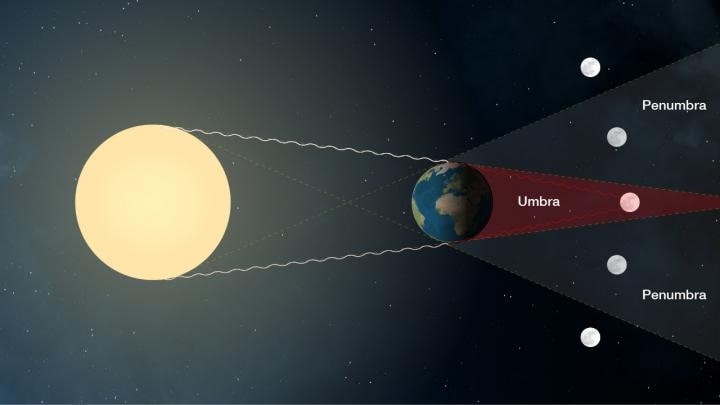
Before answering this question, let’s find out what triggers an eclipse. For the phenomenon to occur, two conditions are necessary at the same time: a full moon and the proximity of our satellite to the node of its orbit (to the point where its orbit intersects the ecliptic plane). At each moment of an eclipse, the degree of the lunar disk’s coverage by the earth’s shadow is expressed by the phase of the eclipse. The magnitude of the phase is determined by the distance from the centre of the Moon to the centre of the shadow. In this regard, scientists distinguish three types of lunar eclipses: total, partial, and penumbral.
As we have already found out, a total eclipse occurs, when the lunar disk completely falls into the umbra (Earth’s shadow) and acquires a crimson hue. A partial eclipse is a situation where only part of the disc falls into the Earth’s shadow, and thus only part of it may appear red. When our satellite falls into the penumbra — the Earth’s half-shadow (see image above) — a penumbral eclipse occurs. In this case, the Moon darkens only a little, and the effect of colouring in red is not observed.
What Is a Super Blood Wolf Moon?
Super Blood Wolf Moon is a type of total lunar eclipse that occurs during a Supermoon and Wolf Moon. Yes, you shouldn’t be surprised, our satellite is so many-sided that it has dozens of names.
A Supermoon is a full moon when our satellite is at its closest distance from the Earth and appears larger and brighter than usual. The first full moon in January is commonly called the Wolf Moon. This name was given to the phenomenon by the Indians of North America, who associated the January crescent with wolves howling on a cold winter night.
Also, our satellite may not be red but blue, which means the second full moon in one calendar month. You probably know about this if you read our article about August Blue Moon.
Other Reasons for the Moon to Become Red
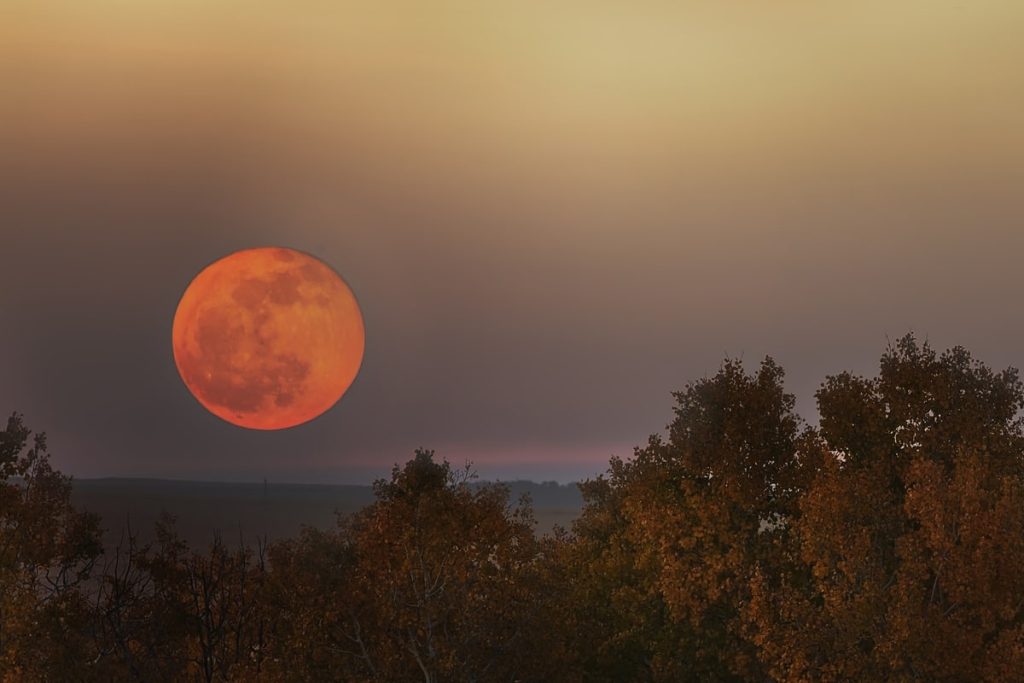
A total eclipse isn’t the only time our satellite can appear red. There are other factors, but they are all related to the scattering of light in the Earth’s atmosphere.
The Moon Is Close to Horizon
The lunar surface may appear red just after it rises or just before it sets. Just as in the case of sunrise and sunset, light from the lunar disk passes through the layers of the atmosphere, and the closer it is to the horizon, the greater the “obstacle” area the light must overcome. Some of the reflected light is scattered, causing the illusion that the Earth’s satellite is turning red.
Polluted Air
In areas of forest fires, hurricanes or volcanic eruptions, the air is filled with particles of small debris, smoke, ash and dust, which partially obscure the light from the Sun and Moon. So, if the Moon is high in the sky and appears red, it may be due to air pollution.
Blood Moon legends and myths from around the world
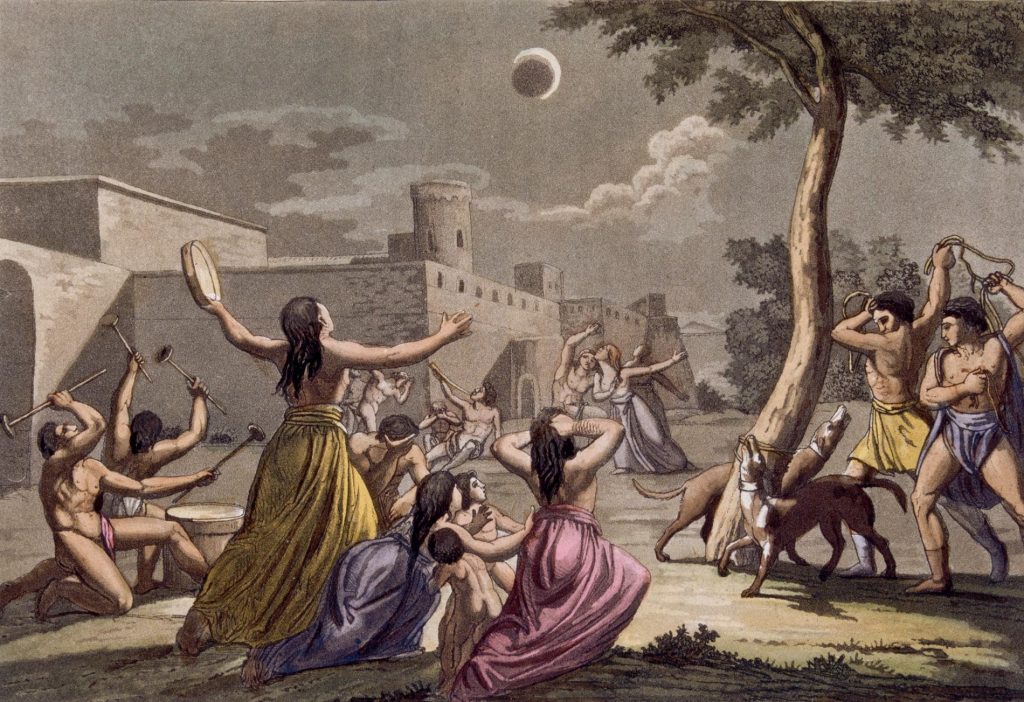
Today, when we know the nature of the phenomenon, we can admire it in the night sky without any fear or prejudice. But ancient people associated the crimson moon with various events, which gave rise to many myths, legends and beliefs.
Mesopotamia
The people of ancient Mesopotamia believed that the Red Moon foreshadowed war, famine, and disease. They tried to prevent these troubles by replacing the king with a figurehead during the eclipse so that he would take on all the evil fate. After the eclipse, the false king was killed, and the real king returned to the throne.
Ancient China
In ancient China, people believed the Moon turned red when the celestial dragon devoured it. To scare the dragon away, they beat drums and gongs, made loud noises, and shot with bows and crossbows. They also sacrificed to the lunar goddess Chang’e to protect the moon from the dragon.
Medieval Europe
In medieval Europe, people associated the Crimson Moon with the apocalypse and the second coming of Christ. They relied on biblical prophecies that said that before the day of judgment, the Sun would darken and the Moon would turn bloody. They also associated a total lunar eclipse with witchcraft, witches, and vampires who allegedly gained power from lunar blood.
How Did the Red Moon Save the Life of Christopher Columbus?

One of the most famous crimson moon stories occurred in 1504 when Christopher Columbus and his crew were stranded on the island of Jamaica. At first, the native Arawak tribe were friendly to them and supplied them with food, but soon relations soured, and the Arawak refused to help. Columbus realized that his people were in danger of starvation unless he found a way to convince the Arawak to cooperate.
Fortunately, the navigator had an almanack, which indicated the dates and times of lunar eclipses. He decided to use this knowledge to impress and intimidate the natives. Having calculated when the next Red Moon is, Columbus told the aborigines that the Christian god was unhappy that the white people were not getting food, and that he would punish the Arawak for this by making the moon red. When this actually happened, the Arawak were scared and brought Columbus and his men lots of food, begging him to pray for them. Columbus agreed and said that he would convince God to return the moon to normal. This is how he saved himself and his crew.
When Is the Next Blood Moon In 2024?
On average, total eclipses make up about 35% of all lunar eclipses, and you can see a crimson lunar disk in the same place about once every 2.5 years. But in 2024, space has deprived us of this pleasure. According to timeanddate.com, this year, we will have one penumbral eclipse on March 25 and one partial eclipse on September 17-18. Both will be highly visible in the UK and Europe and last just over four hours.
But 2025 will fully compensate for this. We will be able to see the crimson moon in the UK twice: March 14 and September 7.
Check out NASA’s detailed calendar of all lunar eclipses through 2030. To find out the eclipse start time for your location, use the Eclipse Guide app.
How to Observe the Blood Eclipse?
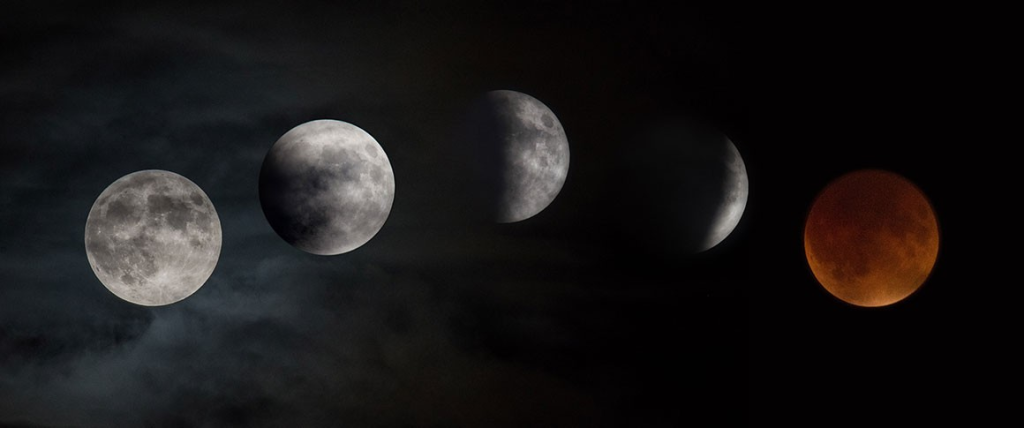
Unlike a total solar eclipse, which is only visible from Earth along a very narrow path for just a few minutes, a total lunar eclipse can be observed by almost everyone with the naked eye on the night side of the Earth. In this case, the possible duration of the total phase of a lunar eclipse can reach 108 minutes; such were, for example, the lunar eclipses of July 26, 1953 and July 16, 2000. These long total eclipses are called central eclipses because our satellite passes through the centre of the Earth’s shadow.
For a comfortable and complete observation of the bloody eclipse, you will need to find a place away from city buildings and other obstacles that obscure your view (forest, mountains), and find a section of the sky without clouds and light pollution.
If you want to make the observation even more interesting and educational, you can use binoculars, a telescope, a camera, and even a smartphone camera with an advanced zoom. With their help, you can see more details of the lunar surface, take beautiful pictures or record videos.
Let’s go hunting for the Blood Moon!
Now that you know what causes a Blood Moon and when is the next one, it is high time to get ready for observation. After all, this is a unique and exciting phenomenon that is worth seeing at least once in your life. But don’t forget that our satellite can also look red in other attention-worthy situations.
References and Additional Information:
- Natural History Museum, “Lunar eclipse guide: what they are, when to see them and where”
https://www.nhm.ac.uk/discover/lunar-eclipse-guide-what-they-are-when-to-see-them-and-where.html
- Eclipses 2024 of Sun and Moon to schedule your dates and not miss them
https://www.yourweather.co.uk/news/trending/eclipses-2024-of-sun-and-moon-to-schedule-your-dates-and-not-miss-them.html
- Columbus and the Night of the Bloody Moon https://www.theguardian.com/science/1999/jul/15/technology
- Watching Lunar Eclipses
https://www.timeanddate.com/eclipse/viewing-lunar-eclipse.html
- Super blood wolf moon: What to know and how to watch it
https://abcnews.go.com/US/super-wolf-blood-moon-watch/story?id=60447831
![Beauty of the Pink Moon And Lyrid Meteor Shower in This Week’s Best Astrophotos [19-26 April] Beauty of the Pink Moon And Lyrid Meteor Shower in This Week’s Best Astrophotos [19-26 April]](https://orbitaltoday.com/wp-content/uploads/2024/04/Pink-Moon-is-on-its-way-above-the-mountains-1-300x300.jpg)




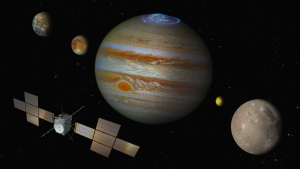
The Blood Moon is such a captivating celestial phenomenon! Your article brilliantly delves into its fascinating blend of scientific explanations and cultural myths. It’s incredible how something as natural as a lunar eclipse can evoke such a wide array of emotions and stories across different cultures. Your breakdown of when and how to observe it is incredibly helpful for anyone eager to witness this spectacle firsthand. Thanks for shedding light on this captivating celestial event!